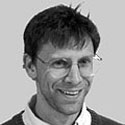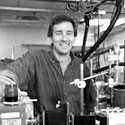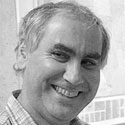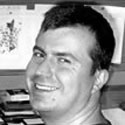
CMCD Director

Stephen C. Harrison
Department of Biological Chemistry and Molecular Pharmacology Harvard Medical School
Children's Hospital Laboratory of Molecular Medicine
http://crystal.harvard.edu
"We are structural biologists concerned with the organization and dynamics of macromolecular assemblies. We ask the following kinds of questions: (1) How do viruses assemble and get into and out of cells? (2) How do proteins that control transcriptional initiation in mammalian cells integrate the multiple signals that impinge on a complex promoter or enhancer? (3) How do clathrin-coated vesicles assemble, recruit cargo, bud off from their membrane of origin, and uncoat? (4) What is the molecular architecture of a kinetochore and how does this architecture embody its required mechanical and signal-transducing properties?"

Jonathan Abraham
Department of Microbiology and Immunobiology, Harvard Medical School
https://www.hms.harvard.edu/dms/bbs/fac/abraham.php
"The Abraham laboratory uses methods in molecular biology, immunology, and structural biology to study host-pathogen interactions with the goal of informing strategies aimed at treating or preventing infection."

Stephen Blacklow
Brigham and Women's Hospital, Department of Pathology
http://blacklow.hms.harvard.edu/
"The long-term goal of my research program is to combine structural and biochemical studies to understand the molecular logic of cell-surface receptors, focusing on proteins implicated in human disease. Over the next several years, we will continue to explore structure-function relationships in proteins of the vascular and hematopoetic systems, with particular emphasis on members of the lipoprotein receptor and Notch families."

Alan Brown
Department of Biological Chemistry and Molecular Pharmacology, Harvard Medical School
https://brown.hms.harvard.edu/
"The Brown lab studies transport mechanisms in the cell. In particular, we are interested in how molecules are transported into, out of, and within cilia and the role this plays in cilium-dependent signaling pathways. To help understand cilia and their dedicated mechanisms, we use a combination of structural, biophysical and biochemical techniques with an emphasis on high-resolution electron microscopy (cryo-EM). We are also interested in developing new methods to accelerate and improve cryo-EM structure determination. In particular how we can improve the interpretation of cryo-EM density maps with all-atom models and make these models as accurate as possible."

Bing Chen
Professor of Pediatrics
Harvard Medical School/ Children's Hospital Boston
Laboratory of Molecular Medicine
Infection by enveloped viruses, such as influenza virus and HIV/SIV, begins with fusion of viral and cellular membranes. The membrane fusion is driven by large conformational changes of the viral envelope glycoproteins when triggered by low pH or receptor binding. Our research is focused on understanding the mechanism of membrane fusion induced by viral fusion proteins. Specifically, we study the conformational changes of the envelope glycoproteins of HIV and SIV during the membrane fusion process by X-ray crystallography, cryo-eletron microscopy and other biophysical and biochemical approaches. The long-term goal of the project is to generate a molecular “movie” illustrating the fusion process and to utilize the structural information to facilitate the development of HIV vaccine and antiviral therapeutics.

Victoria D'Souza
Assistant Professor of Molecular and Cellular Biology
Harvard University
https://www.mcb.harvard.edu/mcb/faculty/profile/victoria-dsouza/
In collaboration with Dr. Stephen Goff’s lab at Columbia University, my goal is to elucidate the solution structure and the mechanisms by which this pseudoknot functions to maintain the Gag/Gag-Pol ratio.

Michael Eck
Dana-Farber Cancer Institute
http://red.dfci.harvard.edu
The Eck laboratory employs biochemical and structural methods (primarily X-ray crystallography) to define the molecular interactions that underlie cytoplasmic signal transduction. The laboratory is especially interested in determining the structure of signaling complexes that underlie cancer, and in using structural approaches to facilitate development of anti-cancer drugs.

Rachelle Gaudet
Department of Molecular and Cellular Biology, Harvard University
https://www.mcb.harvard.edu/directory/rachelle-gaudet/
The Gaudet laboratory uses a combination of x-ray crystallography and other biophysical and biochemical techniques to study the stereochemistry of signaling and transport through biological membranes.

Sun Hur
Department of Biological Chemistry and Molecular Pharmacology, Harvard Medical School
http://hurlab.tch.harvard.edu/
Correct discrimination of âlfâs ân-selfâucleic acids by the innate immune system is essential for host defense against viral infection. A failure to recognize viral nucleic acids can increase a susceptibility to viral infection whereas incorrect recognition of self nucleic acids can lead to autoimmune/inflammatory diseases. Our lab is interested in how the innate immune system can distinguish self from non-self nucleic acids at the level of molecular structures and dynamics.

Tom Kirchhausen
Program in Cellular and Molecular Medicine, Boston Children's Hospital
www.idi.harvard.edu/
"Our research focuses on the processes that mediate and regulate the movement of membrane proteins throughout cells. In particular we study the molecular mechanisms that underlie the cell's sorting machineries responsible for receptor-mediated endocytosis and for secretion. We also study the question of protein networks; their regulation and signal-integration linking the spatial organization of the cortical cytoskeleton in cell with cell migration and growth, antigen presentation and vesicular traffic."

Gaël McGill
Director of Molecular Visualization
Department of Biological Chemistry and Molecular Pharmacology
Harvard Medical School
http://mcgill.med.harvard.edu
http://www.molecularmovies.org
We study ways in which cell and molecular visualization can inform the research and discovery process in addition to its more common role in scientific communications and education. Through collaboration, software development and public outreach efforts, we hope to lay the foundation for a visual operating system for biology - a platform that integrates structural, temporal and geographical datasets. In the face of increasing complexity, we see biovisualization as a key to knowledge synthesis.

Tom Rapoport
Department of Cell Biology, Harvard Medical School
http://cellbio.med.harvard.edu/faculty/rapoport/
Biological cells of higher organisms are complicated structures, containing a number of organelles that are separated from the cytosol by membranes. Each organelle has a characteristic shape and performs special functions that are carried out by different proteins. How do organelles achieve their different structures and receive specific sets of proteins? The answer to these questions is clearly important for an understanding of both how biological structures are generated and how they are propagated during cell division. The problem has relevance for the identification of the basis of diseases in which proteins are misdirected, misfolded, or degraded.

Susan Shao
Department of Cell Biology Harvard Medical School
https://shao.hms.harvard.edu/
"Protein biosynthesis is a complex process encompassing translation, protein folding and posttranslational modifications, and selective targeting to the correct cellular location. Each step is subject to extensive regulation and quality control that is essential for maintaining cellular homeostasis and preventing disease. The Shao lab aims to dissect the molecular mechanisms that determine the fate of new proteins using biochemical, cell biology, and structural biology strategies."

Piotr Sliz
Department of Pediatrics
Department of Biological Chemistry and Molecular Pharmacology
Harvard Medical School
http://hkl.hms.harvard.edu
The Structural Biology Computing Group, SBGrid, focuses on computational methodology, software development, teaching, and support. We are often involved in structure determination of macromolecules at low resolution, where experimental data are limited and demands for computations increased. Recent collaborations with the CMCD laboratories resulted in structures of clathrin coats, Notch complex, and AQP-0 membrane junction.
On the support front, SBGrid manages computing infrastructure of structural biology groups at Harvard and maintains a 144 CPU computing grid for the departments of Cell Biology as well as Biological Chemistry and Molecular Pharmacology. In addition, SBGrid supports scientific computing for more than fifty structural biology groups at eleven universities and research hospitals across the United States.

Timothy Springer
Department of Pathology, Harvard Medical School
Program in Cellular and Molecular Medicine, Boston Children's Hospital
http://www.timothyspringer.org
The Springer lab focuses on integrins, Ig superfamily cell adhesion molecules (CAMs), and selectins. Their work is leading to clinical treatments for autoimmune and vascular diseases.

Gerhard Wagner
Department of Biological Chemistry and Molecular Pharmacology, Harvard Medical School
Dana-Farber/Harvard Cancer Center
MIT/Harvard Center for Magnetic Resonance
http://gwagner.med.harvard.edu
"Our research is concerned with structural aspects of protein function. We are interested in how proteins interact with other macromolecules or small-molecule ligands, and how these interactions relate to biological function. In this context, we are interested in identifying small-molecule inhibitors of functionally important protein interactions. To pursue these goals we use NMR spectroscopy, computational methods and chemical biology approaches."

Jia-huai Wang
Dana-Farber Cancer Institute
wang.dfci.harvard.edu
"Our laboratory has been working on structures of cell surface receptors and their interactions with ligands in immune and nervous systems. One major category is T cell receptors (TCR) and their complexes with antigenic peptides presented by MHC molecules in both class I and II. We have also solved the structures of co-receptors CD8 and CD4 in complex with classic or non-classic MHC molecules. We have provided the structural basis for cellular immune recognition. Cell adhesion is also studied, and is extremely important in immune surveillance and the formation of immunological synapse, the key local contacts between immune cells and antigen-presenting cells. Cell adhesion is also vital for tissue maintenance and nervous system development. Lastly, our lab also carries out structural investigation of virus attachment and entry. We have already worked out four virus receptor structures, including CD4, the receptor for HIV, ICAM-1, the receptor for human rhinovirus, VCAM-1, the receptor for mouse encephalomyocarditis, and CEACAM1a, the mouse hepatitis virus receptor. We have discovered how these similar-looking proteins are subverted to receptors for different viruses. Meanwhile, we are also working on the viral fusion protein and solved structure of HIV gp41 in post-fusion conformation."

Hao Wu
Asa and Patricia Springer Professor of Structural Biology Department of Biological Chemistry and Molecular Pharmacology Harvard Medical School
http://wulab.tch.harvard.edu
"The Wu laboratory focuses on elucidating fundamental molecular mechanisms in immunological processes, in particular signal transduction in innate immunity and antibody diversity in adaptive immunity."
 Copyright © 2012 by the President and Fellows of Harvard College
Copyright © 2012 by the President and Fellows of Harvard College